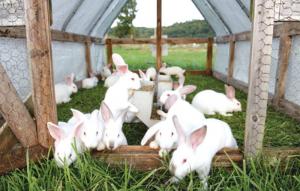2020 - Volume #44, Issue #6, Page #10
[ Sample Stories From This Issue | List of All Stories In This Issue | Print this story
| Read this issue]
How To Profit Raising Rabbits
 |
“I grew up eating rabbit meat,” says Carangelo. “Demand in my area is so strong that I haven’t had to work hard to sell our meat. However, a lot of people who buy our chicken and pork look at the rabbit meat and say, ‘How could you?’”
Carangelo spells it all out in her book “Raising Pastured Rabbits for Meat” where she passes on what she has learned as the manager of livestock and direct markets for Letterbox Farm Collective (LFC).
When she and her husband Laszlo Lazar started raising their own food, rabbit just made sense. She is now responsible for production and marketing 3,000 pastured meat birds a year, around 30 heritage hogs, 500 rabbits, and eggs from 400 laying hens.
Her book is perfect for the person starting or contemplating starting rabbit production. It includes start-to-finish plans for pasture-based production; care and breeding techniques; nutrition guidelines; processing instructions; marketing advice and enterprise plans.
“I thought our market would be high-end foodies and chefs, and while they exist, rabbit is simply traditional fare for a lot of people,” says Carangelo. “It is a staple food in many parts of the world, but they don’t have the luxury of picking it up at the grocery store. If they can find you, they are willing to travel to get it.”
To help her prospective and regular customers find her, Carangelo relies on social media. “You need to be on the internet with a website with good appeal,” she says.
“The biggest factor in failure is poor or inconsistent production,” says Carangelo. “In order to build a market for a product, you have to have a consistent product. People want to know where to go to get what they want. They don’t want to be told you are sold out or have a waiting list.”
A key factor in production, she notes, is a productive herd. “You have to have a herd that breeds easily and regularly for a consistent supply of meat,” says Carangelo. “If you don’t cull does or bucks that aren’t performing, you get small litters or have trouble.”
When production is going smoothly for Carangelo, a 26-doe herd will produce up to 1,000 head of young rabbits a year. She shoots for around 700. At a 55 percent dress out weight, that gives her from 2,100 to 2,450 lbs. of rabbit meat to sell.
Carangelo prefers pasture-raised rabbits. While her book includes different production methods, she goes into the greatest detail on her Wire-Pasture Hybrid method. She keeps breeding pairs in wire cages in a high tunnel hoop house. Grow-outs are moved outside to pasture pens or rabbit tractors at between 6 and 8 weeks of age.
“The pens are easy to move around, escape proof and shielded from the wind, sun and rain,” says Carangelo. “They are a good animal welfare practice and equally good human welfare practice. We don’t have to clean the manure out of barns.”
Each pen holds 24 to 30 rabbits. The 2 by 4-in. wire floors keep the rabbits from digging out, while still able to forage.
“The rumor is that rabbits won’t eat flattened grass, but that’s not true,” says Carangelo. “They will spend all day pulling up grass.”
Contact: FARM SHOW Followup, Letterbox Farm Collective, P.O. Box 84, Hudson, N.Y. 12534 (ph 203 560-0322; letterboxcollective@gmail.com; www.letterboxfarm.com).

Click here to download page story appeared in.

Click here to read entire issue
To read the rest of this story, download this issue below or click here to register with your account number.




